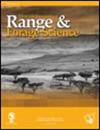Spatio-temporal status of vegetation, soil and cattle serum minerals in degraded communal rangelands of the Eastern Cape, South Africa: implications for livestock sustainability and management interventions
IF 1.9
4区 环境科学与生态学
Q3 ECOLOGY
引用次数: 2
Abstract
In this study, we examined forage, soil and cattle serum mineral status, and their relationships in severely (SD) and less severely (LSD) degraded rangelands, South Africa. Such evidence is essential to inform rangeland policies and interventions. In each rangeland, three villages were identified, and sites near, at intermediate and far distance from homesteads were selected. Soil from LSD had generally greater macro and microelement levels than soil from SD rangelands. Soil elements (i.e. N, P, Mg and Cu) displayed variations at local scale (between villages or distance points from homestead) depending on degradation condition. Degradation level significantly influenced the local distribution of grasses between the distance points from the homestead (Themeda triandra Forssk., Aristida congesta Roem. & Schult.) and between villages [Digitaria eriantha Steud., Eragrostis curvula (Schrad.) Nees, T. triandra]. Forage biomass was low (range: 45–223 kg ha−1) in both degraded conditions. During the dry periods, cattle grazing SD rangelands had most serum minerals below a critical level, but pastures showed Cu and N deficiencies only. We conclude that the low forage yield may limit animal mineral intake. On the other hand, the great abundance of grasses with high forage values (60–76%) indicates that degraded areas may be regenerated. In SD rangelands, complete mineral supplementation is recommended during the dry period.南非东开普省退化公共牧场植被、土壤和牛血清矿物质的时空状况:对牲畜可持续性和管理干预的影响
在这项研究中,我们研究了南非严重(SD)和轻度(LSD)退化牧场的牧草、土壤和牛血清矿物质状况及其相互关系。这些证据对于牧场政策和干预措施至关重要。在每个牧场中,确定三个村庄,并选择离牧场近、中、远的地点。与SD牧场相比,LSD牧场土壤的宏量元素和微量元素含量普遍较高。土壤元素(即N、P、Mg和Cu)在局部尺度上(村庄之间或与宅基地的距离点之间)根据退化情况表现出差异。退化程度显著影响了草地在离草地距离点之间的分布。阿里斯提达。)和村庄之间[Digitaria eriantha Steud]。,《曲形虫》(Schrad.)Nees, T. triandra]。在两种退化条件下,牧草生物量都很低(范围:45-223 kg ha - 1)。在干旱期,SD牧场放牧的牛血清矿物质含量大部分低于临界水平,而牧场只出现Cu和N缺乏。我们认为,低饲料产量可能限制了动物的矿物质摄入量。另一方面,高饲用价值禾草的丰度(60-76%)表明退化区可能得到更新。在SD牧场,建议在干旱期补充完全的矿物质。
本文章由计算机程序翻译,如有差异,请以英文原文为准。
求助全文
约1分钟内获得全文
求助全文
来源期刊

African Journal of Range & Forage Science
ECOLOGY-ENVIRONMENTAL SCIENCES
CiteScore
4.00
自引率
14.30%
发文量
35
审稿时长
>12 weeks
期刊介绍:
The African Journal of Range & Forage Science is the leading rangeland and pastoral journal in Africa. The Journal is dedicated to publishing quality original material that advances rangeland ecology and pasture management. The journal aims to publish research of international importance from any region, but as an African journal, we are particularly interested in research from Africa and relevant to the continent. The Journal promotes both science and its application and authors are encouraged to explicitly identify the practical implications of their work. Peer-reviewed research papers and research notes deal primarily with all aspects of rangeland and pasture ecology and management, including the ecophysiology and biogeochemistry of rangelands and pastures, terrestrial plant–herbivore interactions (both domestic and wild), rangeland assessment and monitoring, effects of climate change on rangelands, rangeland and pasture management, rangeland rehabilitation, ecosystem services in support of production, conservation and biodiversity goals, and the identification and development of intensive and semi-intensive pasture and forage resources to meet livestock production needs. Articles highlighting transdisciplinary linkages among biophysical and social sciences that support management, policy and societal values are particularly encouraged. The Journal includes relevant book reviews and invited perspectives that contribute to the development of range and forage science. Letters to the editor that debate issues raised in the Journal are acceptable. The African Journal of Range & Forage Science is the official journal of the Grassland Society of Southern Africa.
 求助内容:
求助内容: 应助结果提醒方式:
应助结果提醒方式:


